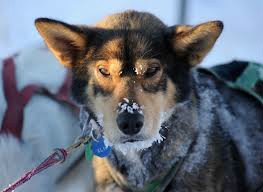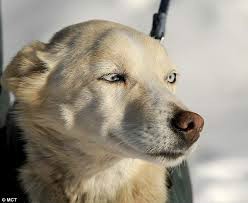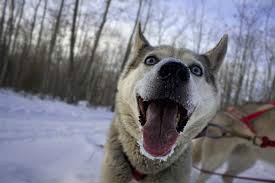The Science BeHind the Alaskan Husky

An Alaskan Husky is essentially a hard working, athletic, and energetic mutt! Their genetic mix typically includes some Siberian Husky and characteristics thought to stem from ancient Northern Native Village dogs. Today's race worthy mixtures incorporate Greyhound, Pointer, Irish Setter, Border Collie, and a variety of other breeds. Mushers will typically breed their best male with their best female to try and retain or enhance such desirable qualities as speed, endurance, a good coat, tough feet, size, intelligence, appetite, drive, and overall attitude.
(Kristy and Anna Berington, http://www.seeingdoublesleddogracing.com)
Alaskan Huskies are smaller than Siberian Huskies and Malamutes. They normally range between 45 and 55 pounds and can look very different: ears up, ears down, black/white/brown fur, blue eyes, brown eyes, one of each! They are all unique in their appearance, but share one common desire...... a passion for running.

Just as a Labrador Retriever loves to swim and retrieve, and a Border Collie loves to herd., Alaskan Huskies love to run. It's in their blood.
Alaskan Huskies love cold weather! They have a very thick double layered coat, which makes them very comfortable in sub-zero temperatures. The combination of a soft, dense under coat and a course outer cost works wonders at protecting the dogs in extreme cold and provides a natural defense against wind, snow, and water. In fact, they prefer running at around 0 degrees Fahrenheit, so they don't overheat.
The challenges of racing mean the dogs eat a lot. In summer when they are not competing, sled dogs consume around 800 calories a day. But during a long, cold winter race, they need 10,000+ calories daily! (Jeff C. Young).
Sled dogs are the world's best athletes. Years of research has proven this. When a sled dog is in his peak condition, his VO2 max (a measure of his ability to take in and use oxygen in the bloodstream) tops out at more than 200 milliliters of oxygen per kilogram of body weight per minute. (Back when Lance Armstrong was racking up multiple Tour de France wins, his famously high VO2 maxed at around 85.) During long distance races, Alaskan huskies are able to run an average of 100 miles a day over eight or nine days, working at 50 percent of his VO2 max for hours on end. As part of a team, sled dogs can run sub-four-minute miles for 60 or 70 miles.

"When it comes down to sheer capacity for prolonged exercise," says Ken Hinchcliff, an Australian veterinary physiologist who's done more research on sled dogs than any other scientist, "there is no other animal, including humans, that comes close to competing." WOW!
|

